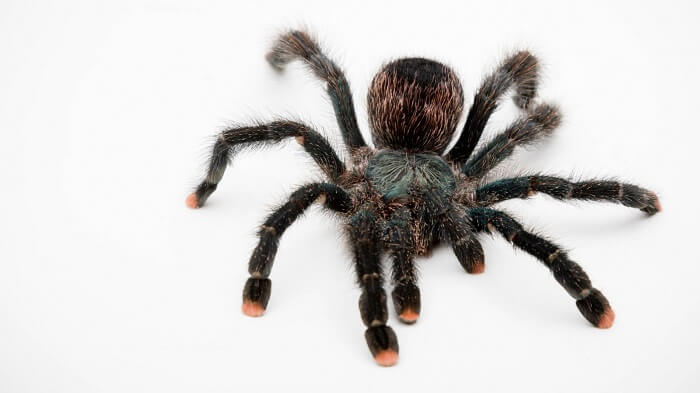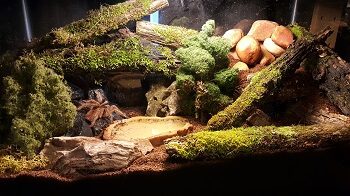
What do tarantulas eat?
October 24, 2021
Facts About The Long Haired Dalmatian
November 9, 2021
Can I keep a tarantula at home? Yes, of course! Although it seems dangerous, it is not quite so. These tarantulas that you can buy are living creatures that produce a major visual impact but are not incredibly hard to keep. These invertebrates can be very spectacular, many types being practically very large, colored, and fluffy.
Tarantulas are becoming more and more popular among those who want to have them as a first pet. They do not require much space; they live between 10-15 years (some live up to 25 years). Being easy to care for and feed, requiring only a water vessel, food once a week, and cleaning every 3 months, they are an alternative to traditional pets at a low cost.
Types of terrariums depending on the tarantula’s type
When you want to buy a terrarium for the tarantula, you need to look first and foremost at the species of the tarantula you hold. As you know there are two large types of tarantulas, more exactly, terrestrial and arboreal.
In the following, I will try to help you understand what kind of terrarium you should get for each of the two types of tarantulas.
For terrestrial tarantulas, the terrarium must have more horizontal space, because this type of spider, in its natural environment, lives at ground level. The height at which the terrarium is placed should be small because they can also climb and fall off. Even though they are not experienced climbers, they can easily die due to their very sensitive abdomen.
In the terrarium layout for terrestrial tarantulas, you must reproduce their natural environment as well as possible. I recommend that you put inside, along with the substrate, various objects where the tarantula can hide such as a piece of coconut, a bark of a tree, or different shapes of ceramics. You can do one yourself or use a pot that you can cut. You can also buy different things from a pet shop.
Now that I’ve talked about the terrarium for terrestrial tarantulas, let’s go into details about the terrarium for arboreal tarantulas.
Arboreal tarantulas are tarantulas that generally live in trees and need a high terrarium that must have something inside that they can climb on, such as tree trunks, tree bark, or any other object that can be found in nature or is imitating the natural environment. However, be careful not to buy something that contains substances that may be damaging to the tarantula. It is not recommended that hard decorative objects such as stones be put in the tarantula’s terrarium.
The proper layout for a tarantula’s terrarium
The size of a terrarium for a tarantula should be at least 30 cm wide and 60 cm long. Tarantulas react pretty badly to stressful situations; they will therefore have to have a place to hide. At the plant level, the ivy plant as well as different branches will give it the perfect hiding place, in addition to allowing it to climb.
The terrarium should have good ventilation so the tarantula does not get sick. Ventilation can be done by creating a series of holes on the sidewalls and the terrarium lid, but it can also be done by creating a wall or wire mesh cover. Special attention should be given to the terrarium lid; if it is made of glass, it must be fixed very firmly, as some tarantulas can easily remove the lid by pushing it to one side. There are several possibilities to create a solid cover. Among these is the one we spoke about earlier – to create a wire mesh cover. If it is from glass, an ingenious system of securing it can be made. For example, stick 2 or more magnets to the glass lid, and a metal angle can be used on the terrarium itself.
At the bottom of the terrarium, an earth substrate should be found. It is recommended to have 10 centimeters or more because some tarantulas have the pleasure of digging. As I said above, it is important to place different objects in the terrarium, but you should choose them according to the type of tarantula you hold. Don’t forget to buy a small water jug, but make sure it isn’t too high so the spider doesn’t drown. Water is vital for the tarantulas, and the water vessel should have a suitable size so that the spider can rest its feet on the opposite edge of the container when the mouth hole touches the water surface.
Temperature and humidity level
 Even if they are not as demanding as reptiles in terms of heat and humidity, the tarantulas still require a minimum of equipment.
Even if they are not as demanding as reptiles in terms of heat and humidity, the tarantulas still require a minimum of equipment.
The terrarium must be positioned somewhere in a darker area of the room because the light bothers them.
They like to live at a temperature between 20 and 25 °C, but it also depends on the species. The temperature in the terrarium should not be less than 18 degrees Celsius. To measure the temperature you can buy a thermometer.
Moisture should also be taken into account. It is particularly important during the period of molting. The humidity is maintained by periodically spraying the substrate of the terrarium. I recommend you buy an analog hygrometer because each type of tarantula needs a certain humidity. However, the soil must not be flooded, as this would encourage the growth of bacteria, fungi, and molds.
It is also necessary to change the water once a week as many terrestrial species leave food as well as feces in the water container. Baby tarantulas and young specimens can live without a water vessel; watering the substrate of the terrarium is enough for them.
Tips:
- Remove the food that has not been consumed from the terrarium.
- It is also necessary to maintain terrarium hygiene and to remove all organic waste (food) after each meal and fecal material.
Pros:
- Low maintenance cost
- Free of smell and noise
- Easy to maintain
- They only need a space of 30x30x20
- They live quite a long time
Cons:
- They feed only on living things
- It is not recommended to handle them as other traditional pets
- You can hardly stop from having one
